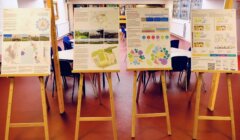Education / Pandemic likely to be factor behind drop in primary school numeracy and literacy attainment
LITERACY and numeracy attainment rates for Shetland’s primary children have dropped slightly since 2019, according to new figures – with the Covid pandemic and the disruption to schools pinpointed as a key factor.
A report to members of Shetland Islands Council’s education and families committee on Monday highlighted a widening in the attainment gap between the most and least disadvantaged primary bairns.
But the council has made “satisfactory progress” in closing the gap against a backdrop of the disruption to education caused by the pandemic, the report said.
An assurance was made that the reasons behind the dip will be looked into – with a number of commitments made to keep improving things in the future.
Broad figures show a four per cent drop fall in overall literacy attainment in primary schools, and a one per cent drop in numeracy.
Lerwick councillor Peter Campbell asked whether the four per cent drop should be considered “significant”.
Children’s services director Helen Budge said: “We don’t like to see any fall in any of our figures. But what we need to do is understand the reason why there has been a fall.”
Quality improvement officer James Johnston said the impact of the Covid pandemic should be viewed as the context behind the figures.
In primaries most children have achieved the expected level of reading, writing, listening, talking and numeracy in 2021.
When the figures are broken down, the biggest drop in attainment between 2018/19 and 2020/21 was seen in P1.
For P4 children it was a mixed bag, with attainment down in listening and talking, and writing, but there was a rise in reading and numeracy levels.
The most positive picture was for P7 children, with figures all on the rise.
But when all taken together the percentage of primary children achieving the expected level of literacy dropped from 63 per cent to 59 per cent.
Become a member of Shetland News
For numeracy the figures represented a marginal drop from 70 per cent to 69 per cent.
For secondary pupils a “stable improvement in attainment” has been recognised, despite the disruption to exams during the pandemic.
A report to councillors said that, when it comes to the primary attainment gap, “more children and young people are living in poverty and there is an expectation that this trend is expected to continue due to the economic downturn caused by the pandemic”.
It contains a number of commitments to improve education for youngsters in 2021/22, including continuing to monitor the impact of Covid-19 on learning and wellbeing, and supporting all schools to accelerate progress on identifying and closing the poverty related attainment gap.
Become a member of Shetland News
Shetland News is asking its readers to consider paying for membership to get additional perks:
- Removal of third-party ads;
- Bookmark posts to read later;
- Exclusive curated weekly newsletter;
- Hide membership messages;
- Comments open for discussion.
If you appreciate what we do and feel strongly about impartial local journalism, then please become a member of Shetland News by either making a single payment, or setting up a monthly, quarterly or yearly subscription.















































































